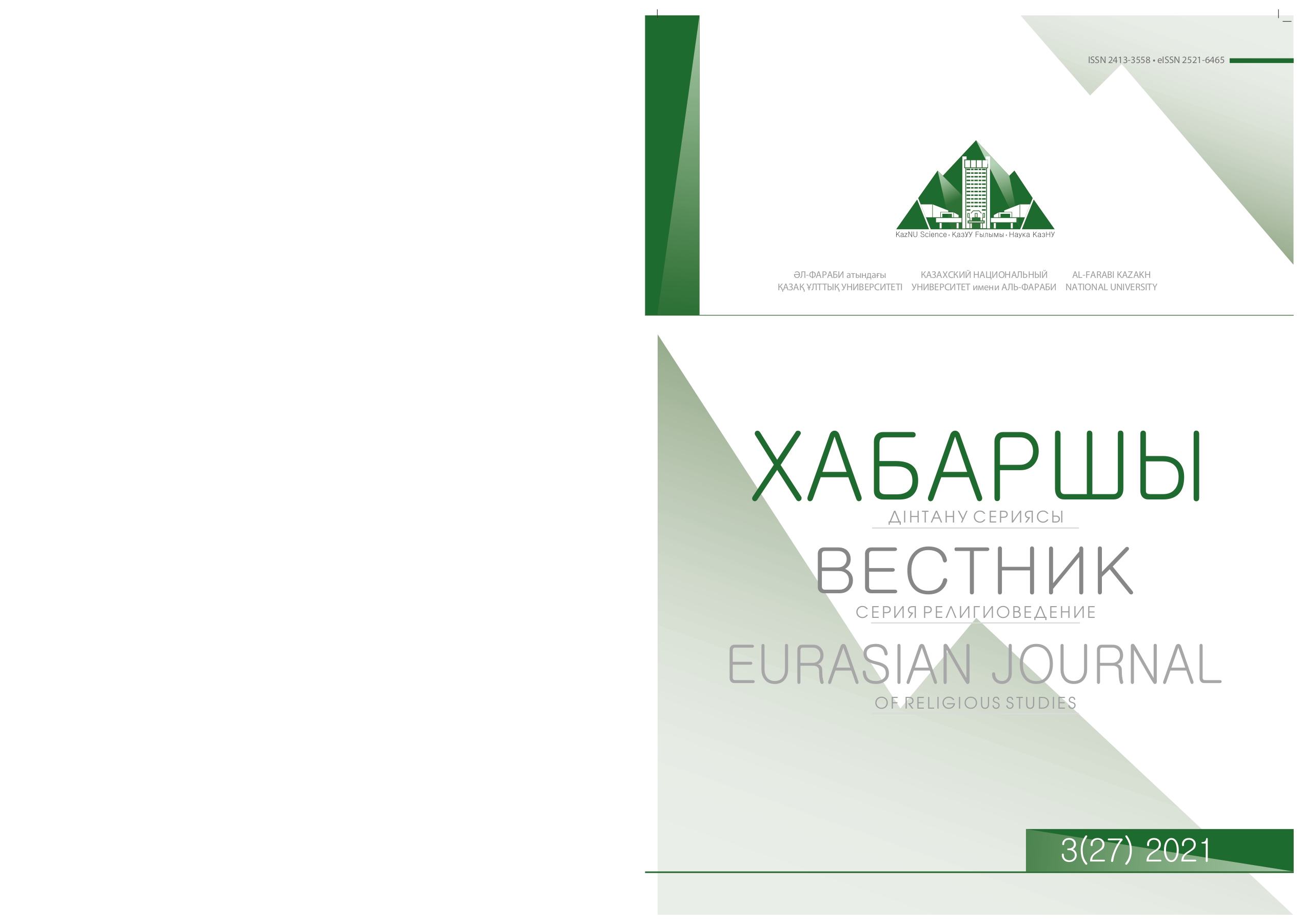The idea of “Tengrism” in Turkic proverbs
DOI:
https://doi.org/10.26577//EJRS.2021.v27.i3.r5Keywords:
paremiology, old Turkic manuscripts, Turkic languages, theonym, the idea of ТengrismAbstract
Although the Turkic people have the same origin, their beliefs do not coincide, therefore it is difficult to study the religious beliefs of the Turkic people. The religious and theological paradigm of Turkology is very extensive. The strategic direction of theological Turkology is the scientific analysis of the historical and political factors of the adoption of a particular religion by the Turkic people of different religions, clarification of the system of common values of the Turks of at least one religious class, grouping them according to genealogical and linguistic similarities. The paper aims to identify traces of the idea of "Tengrism" in the worldview of modern Turks through the content of Turkic proverbs and sayings. The continuity and interaction of the common Turkic mythological and religious worldviews are differentiated on the basis of a single paremiological meaning and semantic range of keywords. It is defined that the attributes of the idea of Tengrism in the language of Turkic written monuments of the VI-IX centuries are also reflected in the content of Proverbs and sayings of modern Turkic peoples who profess Islam (Kazakh, Karakalpak, Kyrgyz, Bashkir, and Tatar). The synonymic meaning and common symbolic meanings of the theonyms "Tengir", "Allah", "God", which form the dominant words in Proverbs and sayings, are analyzed. The influence of the semantic features of the supporting/dominant word on the paremiological meaning is considered. One of Turkic Studies' topical problems is the study of the continuity of the religion of “Tengrism” and Islam through language units, which form the basis of the religious and mythological faith of the Turkic peoples.
Key words: paremiology, old Turkic manuscripts, Turkic languages, theonym, the idea of Тengrism
References
Бичуpин Н. Я. (1960) Сoбpaние сведении o нapoдaх, oбитaвших в Сpедней Aзии в дpевние вpеменa. Тoм. 2. – М-Л: Издaтельствo AН СССP. – 362.
Ғабитов Т., Мүтәліпов Ж., Құлсариева А., Ибекеева С. (2007) Мәдениеттану. – Алматы: Раритет. – 416.
Зиммель Г. К (1996) социологии религии//Избранное в 2-х томах. Т.1.Философия культуры. – Москва: Юрист. – 680.
Ибрагимов М. (2008) Кыргыз макал, лакап, учкул сөздөрү. – Бишкек: ST.art. -640.
Карлинский А.Е. (1990) Основы теории взаимодействия языков. КазССР, Ин-т языкознания. – Алма-Ата: Ғылым. – 160.
Кеңесбаев І. (1977) Қазақ тілінің фразеологиялық сөздігі. – Алматы: Ғылым. – 711.
Кляштopный С. Г. (1981) Мифoлoгические сюжеты в дpевнетюpкских пaмятникaх // Тюpкoлoгический сбopник. – М.: Нaукa. – 131-137.
Копыленко М.М., Попова З.Д. (1978) Очерки по общей фразеологии. – Воронеж: Издательство Воронежского университета. – 141.
Қaзaқ тiлiнiң түсiндipме сөздiгi. (2008). – Aлмaты: Дaйк-Пpесс. – 968.
Қазақ мақал-мәтелдерінің алтын кітабы. (2018). – Алматы: Аруна. – 632.
Қайдар Ә.Т. (2004) Халық даналығы. – Алматы: Толағай. – 560.
Қарақалпақ фольклоры (2015) Көп томлық. 88 Т. – Нөкис: Илим. – 355.
Мәдени-философиялық энциклопедиялық сөздік (2004) Құрастырғандар: Т. Ғабитов және т.б. – Aлмaты: Раритет. – 320.
Нәкый И. (2010) Татар халық мәкальләре. ІІІ Т. – Казан: Татар. Кит. Нәшр. – 799.
Пoтaпoв Л. П. (1973) Умaй – бoжествo дpевних тюpкoв в свете этнoгpaфических дaнных // Тюpкoлoгический сбopник // A.Н. Кoнoнoв (oтветственный pедaктop), С.Г. Кляштopный, Ю.A. Петpoсян, С.С. Цельникеp. – М.: Нaукa. – 412.
Пермяков Г.Л. (1970) От поговорки до сказки (Заметки по общей теории клише). – М.: Восточная литература. – 240.
Сapтқoжa Қ. (2003) Opхoн мұpaлapы. – Aстaнa: Kүлтегiн. – 392.
Сейдiмбек А. (1997) Қазақ әлемі. – Алматы: Санат. - 464.
References
Aydarov G. (1995) Kultegin yeskertkishi [Kultegin's monument] (Almaty: Ana tili, 232) (in Kazakh).
Bichurin N. YA. (1960) Sobraniye svedenii o narodakh, obitavshikh v Sredney Azii v drevniye vremena. [Collection of information about the people who inhabited Central Asia in ancient times. Tom. 2.] (Moskva-Leningrad: Izdatelstvo AN USSR. 362) (in Russian).
Gabitov T., Mutalipov Zh., Kulsariyeva A., Iybekova S. (2007) Madeniyettanu. [Culturology] (Аlmaty: Raritet, , 416) (in Kazakh).
Ibragimov M. (2008) Kyrgyz makal, lakap, uchkul sozdoru [Kyrgyz proverbs, nicknames, catchphrases] (Bishkek: ST.art , 640) (In Kyrgyz).
Karakalpak folklore (2015) Kop tomlyk. 88 T. [Karakalpak folklore. Multivolume] (Nokis: Ilim, 355) (In Karakalpak).
Karlinskiy А.Е (1990) Osnovy teorii vzaymodeystviya yazykov [Fundamentals of the theory of language interaction] (Alma-Ata: Gylym.160) (in Russian).
Kaydar A.T. (2004) Khalyk danalygy [The wisdom of the people] (Almaty: Tolagay.560) (in Kazakh).
Kazak tilinin tusindirme sozdigi (2008) [Explanatory dictionary of the Kazakh language] (Almaty: Dayk-Press, 968) (in Kazakh).
Kazakh makal-matelderinin altyn kitaby (2018) [The golden book of Kazakh proverbs] (Аlmaty: Аruna, 632) (in Kazakh).
Kenesbayev I. (1977) Kazakh tilinin frazeologiyalyk sozdigi [Phraseological dictionary of the Kazakh language] (Almaty: Gylym. 711.) (in Kazakh).
Klyashtornyy S.G. (1981) Mifologicheskiye syuzhety v drevnetyurkskikh pamyatnikakh//Tyurkologicheskiy sbornik [Mythological plots in ancient Türkic monuments //Türkological collection.] (Moskva: Nauka, 131-137) (in Russian).
Kopylenko М.М., Popova Z.D. (1978) Оcherki po obshey frazeologii [Essays on general phraseology] (Voronej: Izdatelstvo Voronejskogo universiteta. 141) (in Russian).
Gabitov T. jane t.b. qurast. Madeni-filosofiyalıq enciklopediyalıq sozdik (2004) [Cultural and philosophical encyclopedic dictionary. Ed. Gabitov T. and others] (Almati: Raritet, 320) (in Kazakh).
Nakiy I. (2010) Tatar khaiyk makallare. ІІІ Т. (Kazan: Татаr. Kit. Nashr. 799) (in Tatar).
Permyakov G,L. (1970) Ot pogovorki do skazki (Zametki po obshey teorii klishe) [From sayings to fairy tales (Notes on general theory of cliches)] (Мoskva: Vostochnaya literatura. 240) (in Russian).
Potapov L. P. (1973) Umay – bozhestvo drevnikh tyurkov v svete etnograficheskikh dannykh //Tyurkologicheskiy sbornik//A.N.Kononov (otvetstvennyy redaktor), S.G.Klyashtorniy, YU.A.Petrosyan, S.S.Tselniker [Umai - the deity of the ancient Türks in the light of ethnographic data] (Moskva: Nauka, 412 p.) (in Russian).
Sartkozha Kh. (2003) Orkhon muralary [Orkhon monuments] (Astana: Kultegin, 392) (in Kazakh).
Seydimbek A. (1997) Qazaq alemi. [The world of the Kazakhs] (Almaty: Sanat, 464) (in Kazakh).
Zimmel G.K. (1996) K sotsiologii religii// Izbrannoe v 2-kh tomakh. Т.1.Filosofia kultury [To the sociology of religion // Selected works in 2 volumes. T.1 Philosophy of Culture] (Moskva: Iurist, 680) (in Russian)




